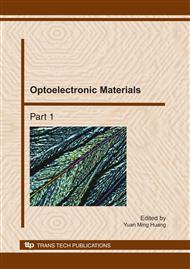p.1225
p.1229
p.1234
p.1238
p.1242
p.1247
p.1252
p.1256
p.1260
ZnO/SiO2 Nanocomposite Cryogels Prepared by Vacuum Freeze Drying
Abstract:
In recent years, ZnO/SiO2 nanocomposite thin films have attracted much attention for a wide range of device applications based on their specific optical and electrical properties. Traditionally, the ZnO/SiO2 nanocomposites were prepared at the form of thin film because the ZnO/SiO2 nanocomposite gels are difficult to synthesize. Therefore, in the present study, a novel route of the mixed ZnO/SiO2 nanocomposite cryogels were prepared by sol-gel technology and dried by vacuum freeze drying. The wet gels were synthesized by co-precursor method with the precursors containing tetraethoxysilane [Si(OC2H5)4,TEOS] and zinc acetate [Zn(CH3COO)2.2H2O]. After vacuum freeze drying, the nanocomposites were annealed at different temperature. The properties of the resulting ZnO/SiO2 nanocomposite cryogels were characterized using Scanning Electron Microscopy (SEM), nitrogen absorption/desorption isotherms, thermogravimetric and differential scanning calorimeter (TG-DSC).
Info:
Periodical:
Pages:
1242-1246
Citation:
Online since:
November 2010
Authors:
Keywords:
Price:
Сopyright:
© 2011 Trans Tech Publications Ltd. All Rights Reserved
Share:
Citation:


